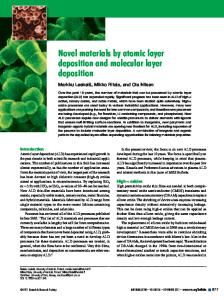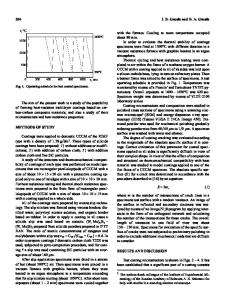Conformal porous carbon coating on carbon fiber cloth/NiS 2 composites by molecular layer deposition for durable superca
- PDF / 849,054 Bytes
- 9 Pages / 584.957 x 782.986 pts Page_size
- 4 Downloads / 969 Views
ATOMIC LAYER DEPOSITION FOR EMERGING THIN-FILM MATERIALS AND APPLICATIONS
Conformal porous carbon coating on carbon fiber cloth/ NiS2 composites by molecular layer deposition for durable supercapacitor electrodes Jia-Bin Fang1, Chang Liu1, Yan-Qiang Cao2,a), Ai-Dong Li1,b) 1
National Laboratory of Solid State Microstructures, Materials Science and Engineering Department, College of Engineering and Applied Sciences, Collaborative Innovation Center of Advanced Microstructures, Jiangsu Key Laboratory of Artificial Functional Materials, Nanjing University, Nanjing, Jiangsu 210093, People’s Republic of China 2 National Laboratory of Solid State Microstructures, Materials Science and Engineering Department, College of Engineering and Applied Sciences, Collaborative Innovation Center of Advanced Microstructures, Jiangsu Key Laboratory of Artificial Functional Materials, Nanjing University, Nanjing, Jiangsu 210093, People’s Republic of China; and School of Science, Nanjing University of Science and Technology, Nanjing 210094, People’s Republic of China a) Address all correspondence to these authors. e-mail: [email protected] b) e-mail: [email protected] Received: 30 August 2019; accepted: 8 November 2019
To solve the poor cyclability of faradic supercapacitors (SCs), the authors reported a unique porous carbon (PC) coating with “gap shell” structure on carbon fiber cloth (CFC)/NiS2 materials. This gap shell PC coating was fabricated by combining atomic layer deposition (ALD) Al2O3 and molecular layer deposition alucone, followed by carbonization and etching. The as-prepared CFC/NiS2/PC composites were directly used as binder-free electrodes for SCs. Benefited from its novel nanostructure, the CFC/NiS2/PC electrode shows a large specific capacitance of 1034.6 F/g at 1 A/g and considerable rate capability of 67% capacitance, retaining ratio within 1–20 A/g. The cyclability of the CFC/NiS2/PC electrode is enhanced by 50% relative to the mere CFC/NiS2 after 2000 cycles, which is attributed to the gap and electrically conductive PC coating. Hence, this work provides a promising approach to design gap shell layer for improved cyclability of faradic SCs and other practical applications in energy storage electronics.
Introduction Supercapacitors (SCs) are emerging as promising energy storage devices for heavy-duty vehicles, portable electronic devices, hybrid platform buses, load systems for intermittent renewable energy sources, and storing the regenerative braking energy of electric vehicles and light rail. They have potential advantages in fast charging, great cycling stability, operational safety, and high power density [1, 2, 3]. In pursuit of SCs with better performance, tremendous progresses have been made on each component in SCs [2]. As one special component, the electrode materials play an important role in the electrochemical performance of SCs [4]. According to the charge storage mechanism, SCs can be generally classified into two types: electrochemical double layer capacitors (EDLCs) and pseudocapacitors. Specifically, EDL
Data Loading...











